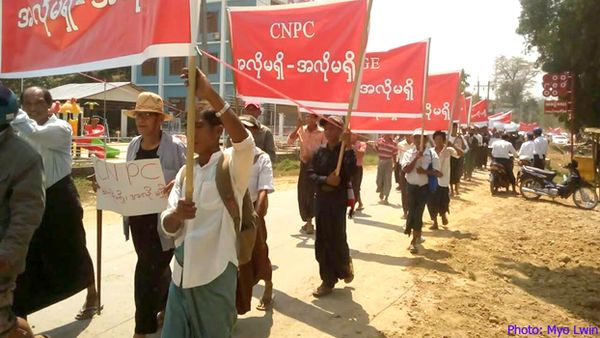Sino-Myanmar Oil Pipeline
| This article is part of the Global Fossil Infrastructure Tracker, a project of Global Energy Monitor and the Center for Media and Democracy. |
| Sub-articles: |
Sino-Myanmar Oil Pipeline is an oil pipeline in Myanmar and China.[1]
Contents
Location
The pipeline originates at the Made Island Oil Terminal at Kyaukphyu Port, Myanmar, and terminates at the Kunming Refinery in Kunming, Yunnan, China.
Project Details
- Operator: CNPC (51%), Myanmar Oil and Gas Enterprise (MOGE, 49%)[1]
- Current capacity: 442,000 barrels per day
- Length: 771 kilometers
- Status: Operating
- Start Year: 2017
Background
Sino-Myanmar pipelines refers to planned oil and natural gas pipelines linking Myanmar's deep-water port of Kyaukphyu (Sittwe) in the Bay of Bengal with Kunming in Yunnan province of China. Talks between China and Myanmar on the feasibility of the project began in 2004.[2]
The plan to build the oil and gas pipelines was approved by China's National Development and Reform Commission in April 2007.[3] In November 2008, China and Myanmar agreed to build a US$1.5 billion oil pipeline and US$1.04 billion natural gas pipeline. In March 2009, China and Myanmar signed an agreement to build a natural gas pipeline, and in June 2009 an agreement to build a crude oil pipeline.[4] The inauguration ceremony marking the start of construction was held on 31 October 2009 on Maday Island.[5][6]
The Myanmar section of the gas pipeline was completed on 12 June 2013 and gas started to flow to China on 21 October 2013.[7][8][9] The oil pipeline was completed in August 2014.[10]
After several years of delay, the pipeline commenced operations in April 2017 after the government of Myanmar agreed to lower transit fees.[11] The pipeline allows China quicker access to oil produced in the Middle East and Africa by avoiding the need to ship the oil through the Straits of Malacca and into the South China Sea. The pipeline terminates at a PetroChina refinery that has the capacity to process 13 million tons a year.[11]
Social and Environmental Impact
The pipeline traverses Ma-De island in Myanmar. Beginning in 2009, residents of Ma-De had their land seized or purchased by the government, and "Fearful of oppression by the junta, most didn't express objections and accepted whatever compensation they were given."[12] According to a November 2015 report by the National Resource Government Institute: "Many villagers still feel unfairly treated; only lands under cultivation were paid for, while plots used for firewood were regarded as 'vacant.' On Ma-De Island, a total of 114 acres belonging to 30 farmers was reportedly seized without compensation."
Opposition
In March 2018 in Rakhine state, Myanmar, approximately 600 people marched to demand compensation for land seized to build the Sino-Myanmar Gas Pipeline and the parallel Oil Pipeline.[13] "Because of this gas pipeline, many villagers lost their land, and CNPC and MOGE haven’t taken any responsibility for it,' said protest leader Zaw Win Lay."[13]
Articles and resources
References
- ↑ 1.0 1.1 Sino-Myanmar Oil Pipeline, Wikipedia, accessed September 2017
- ↑ Storey, Ian (2006-04-12). "China's "Malacca Dilemma"". China Brief 6 (8). Jamestown Foundation. Retrieved on 2008-11-21.
- ↑ "China, Burma Still Discussing Proposed Pipeline", Downstream Today (2008-03-10). Retrieved on 2008-03-11.
- ↑ "Sino-Myanmar Crude Pipeline Memo Signed", Downstream Today (2009-06-19). Retrieved on 2009-07-18.
- ↑ "China starts building Burma pipeline", NHST Media Group (2009-11-03). Retrieved on 2009-11-07.
- ↑ "China starts building Myanmar pipeline", Xinhua, Downstream Today (2009-11-03). Retrieved on 2009-11-07.
- ↑ "Burma Gas Pipeline Complete but Cites China Delays", the irrawaddy (2013-06-12). Retrieved on 2013-06-14.
- ↑ "BChina-Myanmar Gas Pipeline: Myanmar Once Again Getting A Bad Bargain In Chinese Investment", international business times (2013-10-22). Retrieved on 2014-05-14.
- ↑ Shin, Aung (27 October 2013). "Controversial pipeline now fully operational". Retrieved on 31 October 2013.
- ↑ "China-Myanmar joint pipeline starts delivering gas", CCTV.com (2014-06-08). Retrieved on 2014-11-11.
- ↑ 11.0 11.1 China Opens Delayed Myanmar Oil Pipeline to Get Mideast Crude Faster, Bloomberge, 11 Apr. 2017
- ↑ Myanmar Pipeline Brings Gas to China, Hardship to Villagers, National Resource Government Institute, Nov. 5, 2015
- ↑ 13.0 13.1 Hundreds in Myanmar Protest Lack of Payment For Land Confiscated For Pipeline Project Radio Free Asia, Mar. 22, 2018
